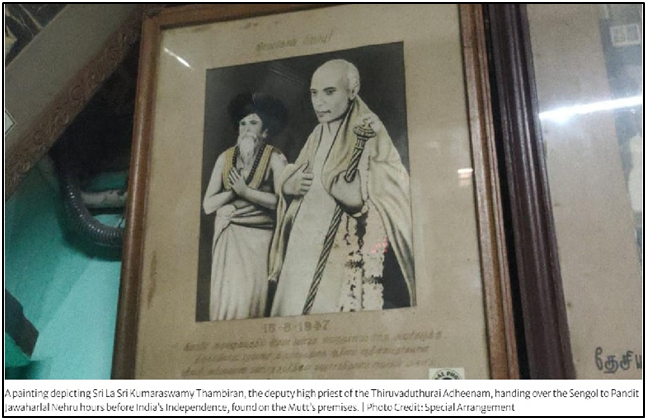Why in news?
- The upcoming inauguration of the new parliament building will also see PM Modi install a historic sceptre from Tamil Nadu next to the Lok Sabha Speaker’s seat.
- The sceptre is known as Sengol — derived from the Tamil word “Semmai”, meaning “Righteousness”.
What’s in today’s article?
- Sengol
- Thiruvavaduthurai Adheenam
Sengol
- Known as Sengol, the sceptre is a “significant historical” symbol of Independence as it signifies the transfer of power from the British to the Indians.
- It was presented to Jawaharlal Nehru, India's first prime minister, as a symbol of the transfer of power from the British.
History of Sengol
- Question over nature of ceremony to symbolise the transfer of power from British to Indian hands
- What is the ceremony that should be followed to symbolise the transfer of power from British to Indian hands?
- This was the question posed by the then Viceroy Lord Mountbatten to the to-be Prime Minister Jawaharlal Nehru.
- Nehru then consulted C. Rajagopalachari, commonly known as Rajaji, who went on to become the last Viceroy of India.
- Chola model was followed
- Rajaji identified the Chola model where the transfer of power from one king to another was sanctified and blessed by a high ruler.
- The symbol used was the handover of ‘sengol’ or sceptre from one king to his successor.
- Making of Sengol
- The Sengol was constructed by two men — Vummidi Ethirajulu and Vummidi Sudhakar, both are still alive and remember making it.
- A golden sceptre was crafted by Vummidi Bangaru Chetty, a famous jeweller in the Madras Presidency.
- The sceptre measures five feet in length and has a ‘Nandi’ bull on top, symbolising justice.
- The ‘handing over’ ceremony that happened on Independence Day eve
- As per the official document, three people brought in the newly-made Sengol from Tamil Nadu.
- These three people were:
- the deputy high priest of Thiruvavaduthurai Adheenam (a 500-year-old Saivaite monastery),
- nagaswaram player Rajarathinam Pillai, and
- an Odhuvar (a person who sings devotional songs in Tamil temples).
- The ceremony was conducted as per Tamil traditions and the sengol was handed over to Nehru at his house.
- During the ceremony, which took place on August 14, 1947, a priest gave the sceptre to Lord Mountbatten and then took it back.
- It was then taken in procession to Pt Jawaharlal Nehru’s house, where it was handed over to him.
- A special song was rendered, as specified by the high priest.
- The song played during the ceremony was composed by the 7th-century Tamil saint Tirugnana Sambandar — a child prodigy who lived only 16 years.

Thiruvavaduthurai Adheenam
- About
- It is a prominent Shaiva monastic organization or mutt (matha) based in Tamil Nadu, India.
- The mutt is located in Dharmapuram, a town in the Mayiladuthurai district of Tamil Nadu.
- It is one of the oldest and most revered Adheenams (monastic institutions) in the Shaiva tradition.
- It was established in the 10th century by the sage Tirugnana Sambandar, who was one of the four main Nayanars (saints) of Shaivism.
- Features
- The Adheenam is primarily focused on promoting and preserving the teachings, rituals, and practices of Shaivism.
- The Adheenam is involved in publishing Saivite literature, specifically Thevaram and Tiruvasakam and its translations.
- The head of the Thiruvavaduthurai Adheenam holds the title of "Adheenakarthar" and is considered a spiritual leader and guide for the followers.










